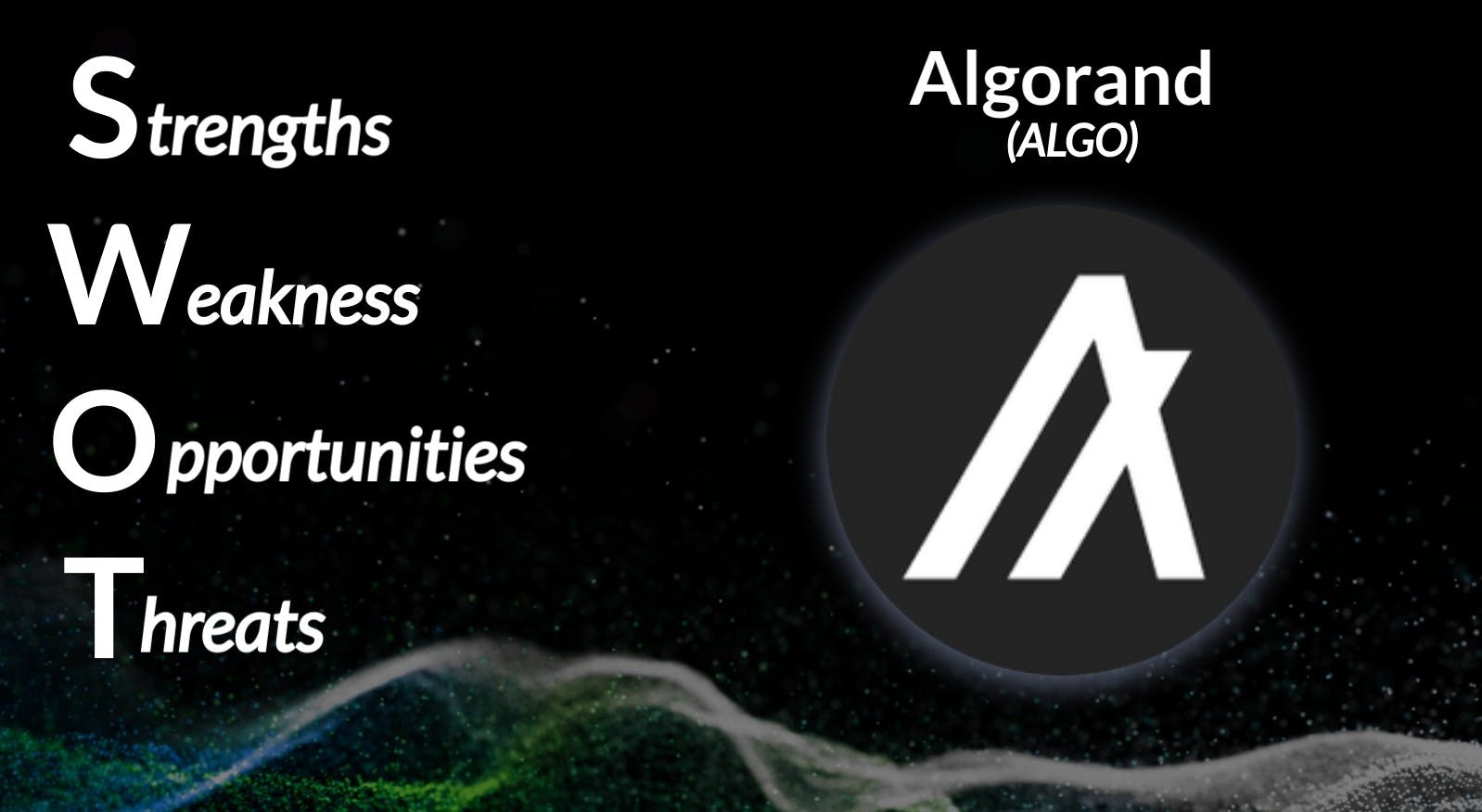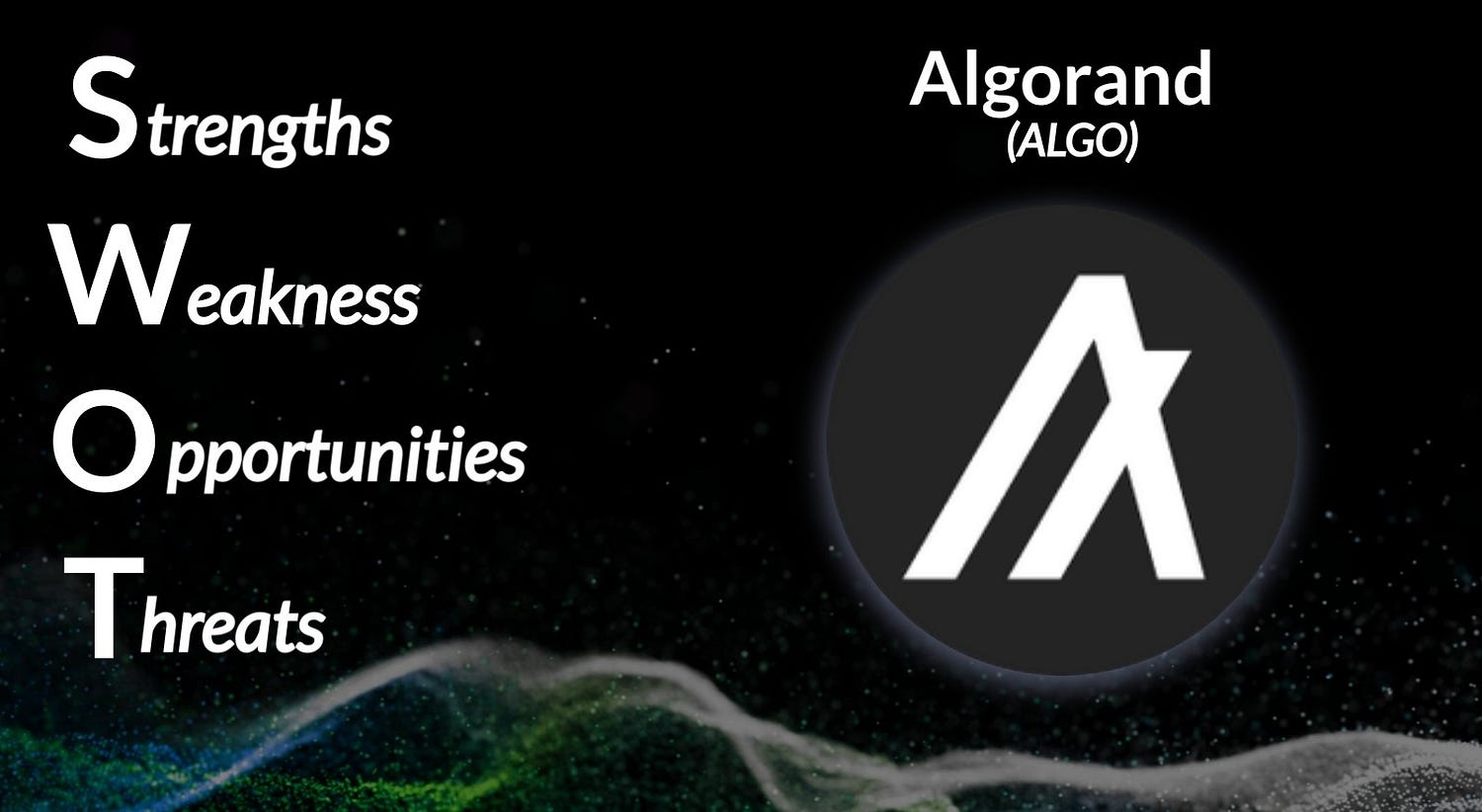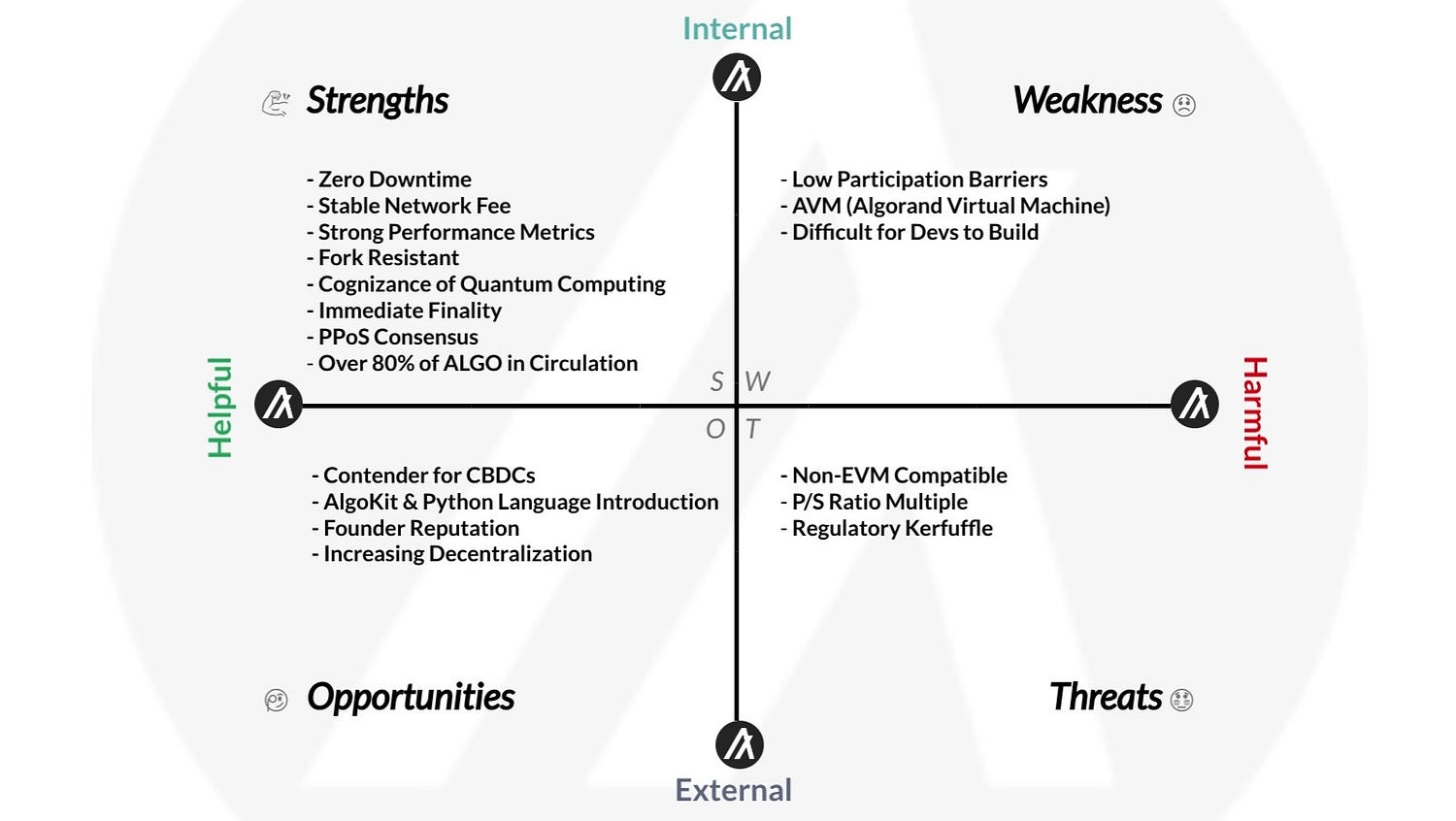
SWOT Analysis: Algorand (ALGO)
*Note: a SWOT analysis is an evaluation of the fundamental, operational, technical, social, economic, and even to some degree administrative elements of a project. This is not a model to be used for trading purposes. (NFA, DYOR)

Composed of four elements, Strengths, Weaknesses, Opportunities, and Threats, a SWOT analysis framework provides excellent insight for establishing a high-level understanding of the state of a project’s well-being through the lens of a birds-eye view.
It can help formulate decisions around which areas require more attention, set performance goals, and organize a foundational understanding of where a project is headed.
Rarely (if ever) used in crypto, it is time to apply this timeless method of evaluation to the digital asset space.
Today, Algorand (ALGO), the second-generation, enterprise-grade, non-EVM compatible layer one blockchain, will get a SWOT.

💪 Strengths (Internal) (Helpful)
1. Zero Downtime
In the case of open, public blockchains, there is no room for downtime. Notable projects have experienced outages previously (Solana, Arbitrum), which continue to be a haunting topic weaponized against them. Since its launch in 2019, four years of uninterrupted operations have given Algorand due credibility in terms of its network reliability. Factoring in that Algorand has opted for growth via enterprise (rather than individual consumers), up-time is a non-negotiable pre-requisite.
2. Stable Network Fee
Consumers dont like volatility. The long and short of it is that in order for any blockchain applications to achieve the vision of integrating Web3 into the fabric of society, products must be produced with mass appeal/usability. Volatility is a tremendous deterent for non-crypto natives adopting any application in a meaningful way. It create more complexity for companies trying to develop product and adds congitive load on the consumer experience. Not to mention that governments and enterprise grade organizations prefer solutions that can povide some sense of stability. Due to technical nuances in the Algorand Virtual Machine, transactions of any complexity can be executed at a fixed, predictable cost (0.001 ALGO). While the fee does have some fluctuations during congested periods, they are immaterial in the grand context of things.
3. Strong Performance Metrics
With the potential to sustain up to 10,000 TPS, with a 3.3 -second block time and instant finality, Alogrand has been able to attract quite a bit of attention, which can be seen by impressive metrics of the on-chain data. Daily transaction count is easily eclipsing >600,000. Per block TX floating above 40. Total Value Locked (TVL) exceeding 150 million. Nearly 100,000,000 in stablecoins are on-chain, even after the marketwide collapse. Decently diverse DEFI landscape with over 30 protocols (and counting). Over 1,000 nodes. Over ~7.5 million, and growing, different ASA (Algorand Standard Assets) have been issued. Average on-chain balance compressed from 6,800 to 5,100 alongside massive injections of ALGO tokens into circulation (7.1 B to 8.4 B), signaling an increasing distribution of holders (4,000,000 new accounts over the course of a year).
4. Fork Resistant
Forks, also known as partitions, are a common occurrence in distributed environments where a slip in communication channels causes validator nodes to simultaneously produce different blocks, causing the chain to split and disrupt network functionality. These disruptions invite malicious actors to subvert the system for monetary gain, such as through double-spending. Algorand made a conscious decision in the architecture of its network where Consistency is more important than Availability. Thus, in the event of a partition, the network halts, stopping any activity from taking place until the fork is resolved. This philosophical approach creates a more secure environment.
5. Cognizance of Quantum Computing
Quantum computing is the next frontier in terms of evolution for hardware. Still unclear about the full range of its implications, one thing that is certain is that in the presence of quantum computing, certain mathematical logic will break. Among those things are algorithms underpinning blockchains. Preparing for a post-quantum world shows a high level of commitment to the security of a network. Through a combination of State-Proofs and the integration of a lattice-based digital signature scheme called Falcon, Algorand is already imbued with quantum-resistant properties.
6. Immediate Finality
Public blockchains are known for their delayed, if not perpetually probable, finality issues that have resulted in chain rollbacks. Rollbacks are what they sound like, essentially unwinding some portion of historical activity. Events that can cause unintended economic disruptions on both commercial and personal levels. Finality is the guarantee that a transaction cannot be reverted. The quicker the finality, the higher the degree of certainty and the more comfortable users are. Alogrand’s One-Block finality creates a digital environment that is highly desirable for enterprise-grade, mission-critical applications.
7. PPoS Consensus
Whenever a crypto project puts emphasis on developing novel approaches for achieving consensus in a decentralized environment, it shows a great deal of industry understanding and desire to innovate. In alignment with its desire for carbon neutrality and energy efficiency, Algorand has developed an adaption of PoS consensus called PPoS (Pure-Proof-of-Stake). One of the most attractive attributes of PPoS is that it is maximally inclusive with a very accessible 1 ALGO token requirement for participating.
8. Over 80% of ALGO in Circulation
The higher the total amount of a token there is in circulation, the more likely it is that distribution is higher, and the price is closer to being absolved of selling pressure from new tokens coming into the market, ultimately allowing for a higher degree of freedom for price discovery by natural market forces. Taking into consideration the broader crypto landscape, Algorand is easily in the upper tier of circulating supply.
😞 Weaknesses (Internal) (Harmful)
1. Low Participation Barriers
A tradeoff that is made in the presence of the PPoS mechanism. Being maximally inclusive may sound appealing on the surface, but in practice, a duality arises, revealing unintended security implications. With lower barriers to entry, participants suffer from the tragedy of the commons, where the low nominal stake value is not strong enough to truly engage users. Less engagement from the users results in an environment where subtle coercion can take place, and nobody will have the motivation/incentive to prove, inspect, or challenge anything. The more skin in the game, the more committed a user, the stronger the social feedback, the more resilience against malicious actors.
2. AVM (Algorand Virtual Machine)
Granted, there are benefits in having a custom virtual machine, such as can be seen with the AVM’s ability to sustain transaction prices regardless of a transaction’s complexity. A regular send, multi-send, and contract execution all have the same network cost. However, on the flipside, having a separate VM means having design specifications that are not universally adopted, in turn depriving Algorand of the existing infrastructure.
3. More Difficult for Devs to Build
Tightly related to the use of its own virtual machine, Algorand requires its own specialized knowledge. The project is developed with a language called Teal, a very obscure, non-developer-friendly option. This causes a severe disconnect as devs won’t want to learn a new language, users won’t be able to interact with the ecosystem due to a lack of products, and companies are forced to spend much more money in search of qualified personnel just to build on Algorand.
Opportunities (External) (Helpful)
1. Contender for CBDCs
A point that is contested by many crypto natives, Central Bank Digital Currencies are one of the killer potential use cases for crypto as a whole. Algorand has been developing relationships with nations and banks to conduct programs on the network. Winning in this domain can result in influxes of capital denoted in the hundreds of billions, if not trillions of dollars.
2. Algokit and Python Language Introduction
Acutely aware of the issues facing Algorand with not being friendly to developers, the project has put efforts towards the creation of Providing assistance across the entire lifecycle of the creative process, from back-end dapp to front-end interface, Algokit 2.0, is a suite of tools to help developers. A major part of the solution will introduce Python for programming. Comparing Python’s huge base of 8.2 million devs to Teal’s unknown/unmeasured dev base, the impacts in terms of creative space become exponential. With an excellent recursive feedback loop, where more devs make more apps, more apps invite more users who are searching for more apps, which invites more devs to build.
3. Founder Reputation
Silvio Micali is a highly respected individual in the field of cryptography and information security. Being a Turing award winner, Micali was the co-inventor of zero-knowledge proofs, probabilistic encryption, VRFs (Verifiable Random Functions), and many other innovations. Oh, he also holds 47 patents across concepts, including RNG (random number generation), identification schemes, digital signatures, digital certificates, electronic transactions, and the like. His reputation has bled into the fibers of the project and given it extreme credibility among the scholarly and technological communities.
4. Increasing Decentralization
As it relates to consensus, the communications taking place on Algorand currently happen through a hub-and-spoke model, where messages are propagated through a network of tightly knit nodes (a notoriously more centralized architecture). These consensus nodes do not receive any rewards for participating. If nodes have no incentive to participate in consensus, then only large insiders will take over the network because smaller players will simply not want to allocate their resources. The project intends on transcending into a mode decentralized version of itself by implementing a peer-to-peer gossip protocol for nodes to disseminate information and activating incentivized consensus.
😳 Threats (External) (Harmful)
1. Non-EVM Compatible
Ethereum’s VM is the industry’s most popular environment, it hosts the most diversity in technological exploration, the largest community, the most liquidity, the most developers, and the most applications. Deploying a network that does not natively interact with EVM means depriving it of a robust, flourishing external ecosystem. As it stands today, the thought of successful non-EVM environments brings to mind Solana (alongside a graveyard of ghost chains). In the likely event that the EVM, in fact, does become a fundamental building block in Web3, alternative approaches might be disregarded.
2. P/S Ratio Multiple
The ratio of Price-to-Sale is a measurement used to establish the "fair value" of an asset that has been adapted from traditional finance. In crypto, the Price is a project's market cap, and the Sales are network revenues. The current market cap of ALGO is roughly $1 Billion USD ($1,000,000,000); last year (marked Q3 of 2022 until today), the network earned $78,000; by dividing the MCAP/Earnings, we arrive at a ratio of >12,000. That means the "fair value" of ALGO is currently 12,000 times higher than it should be based on how much economic value its network captured. Currently, this metric alone does not dictate an accurate truth (as it omits over vectors of value); however, the sheer magnitude of this ratio should not be glossed over.
3. Regulatory Kerfuffle
Algorand was long endorsed (at least for its technology) by SEC chairman Gary Gensler before Gary decided to flip the script on the crypto industry. ALGO fell into the group of layer one projects that were targeted by the SEC. This created uncertainty and confusion within the community and resulted in many documents disappearing from Alogrand’s website (such as the government resources…). The image of Gary Gensler’s being (indirectly) associated with the project is a sh*t stain across the windshield of its life, similar to the role of SBF in relation to Solana.
Takeaway:
Not your typical degen chain.
Elegant and sophisticated with an intellectual ambiance.
Obviously, it is very quality-oriented and focused on the fundamentals.
Technology and reputation are the drivers of ALGO. Adoption, not so much.
Conclusion:
Algorand pats itself on the back a lot for solving the blockchain trilemma with its technology that is scalable, secure, and decentralized.
We don’t agree. We think that Algorand is using its definitions of what “decentralization” is to come to this conclusion. Simply put, the system does not employ consensus rewards, and all emissions are actually happening by distribution from the Algorand Foundation. That is centralization. (This is not a knock against the project, simply an opinion).
Regardless of conflicting thoughts, the project is tier-one (at least in part due to it riding the clout of having Silvio as its founder).
The true performance capabilities of Algorand are yet to be put to the test. Even though songs of 10,000 TPS are sung, the network utilization actually peaked in December of 2021 at an average of 46.
All of this said, if we had to ascribe a Web2 comparative to Algorand; companies such as Oracle and Sales Force come to mind.
To close this out, it would be unfair not to address the ALGO community and communications. Algorand’s foundation and community have put forth a lot of efforts and created a strong presence, with a lot of helpful content and documentation.
Thank you so much for reading,
I hope this serves you well on your journey.
Live long and prosper 🥂


